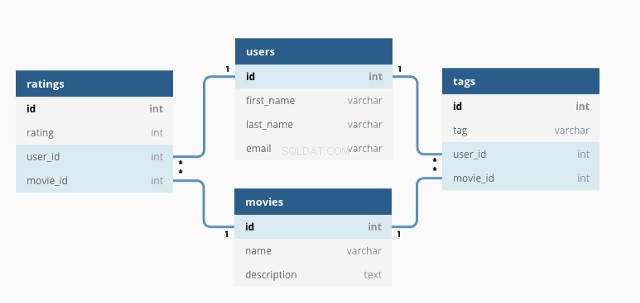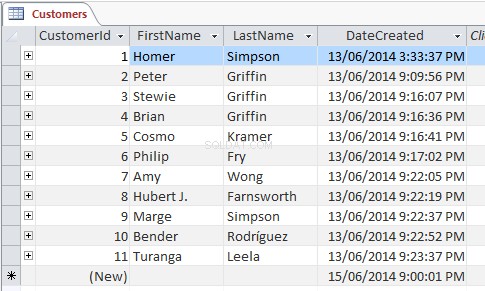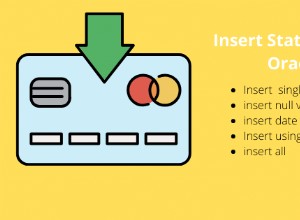Jestem badaczem AI, więc jedną z głównych rzeczy, którymi się zajmuję, są dane. dużo z tego.
Ponad 2,5 eksabajta danych generowanych codziennie , nie jest niespodzianką, że te dane muszą być przechowywane w miejscu, z którego możemy uzyskać do nich dostęp, gdy ich potrzebujemy.
Ten artykuł przeprowadzi Cię przez hackowalną ściągawkę, która pozwoli Ci szybko rozpocząć pracę z SQL.
Co to jest SQL?
SQL oznacza Structured Query Language. Jest to język dla systemów zarządzania relacyjnymi bazami danych. SQL jest dziś używany do przechowywania, pobierania i manipulowania danymi w relacyjnych bazach danych.
Oto jak wygląda podstawowa relacyjna baza danych:

Używając SQL, możemy wchodzić w interakcje z bazą danych, pisząc zapytania.
Oto jak wygląda przykładowe zapytanie:
SELECT * FROM customers;
Korzystanie z tego SELECT oświadczenie, zapytanie wybiera wszystkie dane ze wszystkich kolumn w tabeli klienta i zwraca dane w następujący sposób:

Symbol wieloznaczny gwiazdki (*) odnosi się do „wszystkie ” i zaznacza wszystkie wiersze i kolumny. Zamiast tego możemy go zastąpić określonymi nazwami kolumn — tutaj tylko te kolumny zostaną zwrócone przez zapytanie
SELECT FirstName, LastName FROM customers;
Dodawanie WHERE klauzula umożliwia filtrowanie tego, co zostanie zwrócone:
SELECT * FROM customers WHERE age >= 30 ORDER BY age ASC;To zapytanie zwraca wszystkie dane z tabeli produktów z wikiem wartość większa niż 30.
Użycie ORDER BY słowo kluczowe oznacza po prostu, że wyniki zostaną uporządkowane według kolumny wieku od najniższej wartości do najwyższej
Korzystanie z INSERT INTO oświadczenie, możemy dodać nowe dane do tabeli. Oto podstawowy przykład dodawania nowego użytkownika do tabeli klientów:
INSERT INTO customers(FirstName, LastName, address, email)
VALUES ('Jason', 'Dsouza', 'McLaren Vale, South Australia', '[email protected]');Oczywiście te przykłady pokazują tylko bardzo mały wybór możliwości języka SQL. Dowiemy się więcej na ten temat w tym przewodniku.
Dlaczego uczyć się SQL?
Żyjemy w epoce Big Data, w której dane są szeroko wykorzystywane do znajdowania spostrzeżeń i informowania o strategii, marketingu, reklamie i wielu innych operacjach.
Duże firmy, takie jak Google, Amazon, AirBnb, wykorzystują duże, relacyjne bazy danych jako podstawę poprawy obsługi klienta. Zrozumienie SQL to świetna umiejętność nie tylko dla naukowców zajmujących się danymi i analityków, ale dla każdego.
Jak myślisz, że nagle dostałeś reklamę butów na YouTube, kiedy zaledwie kilka minut temu wyszukiwałeś w Google swoje ulubione buty? Tak działa SQL (lub forma SQL)!
SQL kontra MySQL
Zanim przejdziemy dalej, chcę tylko wyjaśnić często niejasny temat — różnicę między SQL a MySQL. Jak się okazuje, nie są to samo!
SQL to język, podczas gdy MySQL to system do implementacji SQL.
SQL przedstawia składnię, która umożliwia pisanie zapytań, które zarządzają relacyjnymi bazami danych.
MySQL to system bazy danych który działa na serwerze. Umożliwia pisanie zapytań przy użyciu składni SQL do zarządzania bazami danych MySQL.
Oprócz MySQL istnieją inne systemy, które implementują SQL. Niektóre z bardziej popularnych to:
- SQLite
- Baza danych Oracle
- PostgreSQL
- Microsoft SQL Server
Jak zainstalować MySQL
W większości przypadków MySQL jest preferowanym wyborem dla systemu zarządzania bazami danych. Wiele popularnych systemów zarządzania treścią (takich jak Wordpress) domyślnie używa MySQL, więc używanie MySQL do zarządzania tymi aplikacjami może być dobrym pomysłem.
Aby korzystać z MySQL, musisz zainstalować go w swoim systemie:
Zainstaluj MySQL w systemie Windows
Zalecanym sposobem instalacji MySQL w systemie Windows jest użycie instalatora MSI ze strony MySQL.
Ten zasób poprowadzi Cię przez proces instalacji.
Zainstaluj MySQL na macOS
W systemie macOS instalacja MySQL obejmuje również pobranie instalatora.
Ten zasób poprowadzi Cię przez proces instalacji.
Jak korzystać z MySQL
Po zainstalowaniu MySQL w twoim systemie zalecam użycie jakiejś aplikacji do zarządzania SQL aby zarządzanie bazami danych było znacznie łatwiejszym procesem.
Do wyboru jest wiele aplikacji, które w dużej mierze wykonują tę samą pracę, więc wybór zależy od Twoich osobistych preferencji:
- MySQL Workbench opracowany przez Oracle
- phpMyAdmin (działa w przeglądarce internetowej)
- HeidiSQL (zalecane dla Windows)
- Sequel Pro (zalecane dla macOS)
Kiedy będziesz gotowy do rozpoczęcia pisania własnych zapytań SQL, rozważ importowanie fikcyjnych danych zamiast tworzenia własnej bazy danych.
Oto kilka fikcyjnych baz danych, które można pobrać bezpłatnie.
Ściągawka SQL – wisienka na torcie
Słowa kluczowe SQL
Tutaj można znaleźć zbiór słów kluczowych używanych w instrukcjach SQL, opis i, w stosownych przypadkach, przykład. Niektóre z bardziej zaawansowanych słów kluczowych mają własną dedykowaną sekcję.
Tam, gdzie MySQL jest wymieniony obok przykładu, oznacza to, że ten przykład ma zastosowanie tylko do baz danych MySQL (w przeciwieństwie do jakiegokolwiek innego systemu baz danych).
ADD -- Adds a new column to an existing table
ADD CONSTRAINT -- Creates a new constraint on an existing table, which is used to specify rules for any data in the table.
ALTER TABLE -- Adds, deletes or edits columns in a table. It can also be used to add and delete constraints in a table, as per the above.
ALTER COLUMN -- Changes the data type of a table’s column.
ALL -- Returns true if all of the subquery values meet the passed condition.
AND -- Used to join separate conditions within a WHERE clause.
ANY -- Returns true if any of the subquery values meet the given condition.
AS -- Renames a table or column with an alias value which only exists for the duration of the query.
ASC -- Used with ORDER BY to return the data in ascending order.
BETWEEN -- Selects values within the given range.
CASE -- Changes query output depending on conditions.
CHECK -- Adds a constraint that limits the value which can be added to a column.
CREATE DATABASE -- Creates a new database.
CREATE TABLE -- Creates a new table.
DEFAULT -- Sets a default value for a column
DELETE -- Delete data from a table.
DESC -- Used with ORDER BY to return the data in descending order.
DROP COLUMN -- Deletes a column from a table.
DROP DATABASE -- Deletes the entire database.
DROP DEAFULT -- Removes a default value for a column.
DROP TABLE -- Deletes a table from a database.
EXISTS -- Checks for the existence of any record within the subquery, returning true if one or more records are returned.
FROM -- Specifies which table to select or delete data from.
IN -- Used alongside a WHERE clause as a shorthand for multiple OR conditions.
INSERT INTO -- Adds new rows to a table.
IS NULL -- Tests for empty (NULL) values.
IS NOT NULL -- The reverse of NULL. Tests for values that aren’t empty / NULL.
LIKE -- Returns true if the operand value matches a pattern.
NOT -- Returns true if a record DOESN’T meet the condition.
OR -- Used alongside WHERE to include data when either condition is true.
ORDER BY -- Used to sort the result data in ascending (default) or descending order through the use of ASC or DESC keywords.
ROWNUM -- Returns results where the row number meets the passed condition.
SELECT -- Used to select data from a database, which is then returned in a results set.
SELECT DISTINCT -- Sames as SELECT, except duplicate values are excluded.
SELECT INTO -- Copies data from one table and inserts it into another.
SELECT TOP -- Allows you to return a set number of records to return from a table.
SET -- Used alongside UPDATE to update existing data in a table.
SOME -- Identical to ANY.
TOP -- Used alongside SELECT to return a set number of records from a table.
TRUNCATE TABLE -- Similar to DROP, but instead of deleting the table and its data, this deletes only the data.
UNION -- Combines the results from 2 or more SELECT statements and returns only distinct values.
UNION ALL -- The same as UNION, but includes duplicate values.
UNIQUE -- This constraint ensures all values in a column are unique.
UPDATE -- Updates existing data in a table.
VALUES -- Used alongside the INSERT INTO keyword to add new values to a table.
WHERE -- Filters results to only include data which meets the given condition.
Komentarze w SQL
Komentarze pozwalają wyjaśnić sekcje instrukcji SQL bez bezpośredniego wykonywania.
W SQL istnieją 2 rodzaje komentarzy, jednowierszowe i wielowierszowe.
Komentarze jednowierszowe w SQL
Komentarze jednowierszowe zaczynają się od „- -”. Każdy tekst po tych 2 znakach do końca linii zostanie zignorowany.
-- This part is ignored
SELECT * FROM customers;Komentarze wielowierszowe w SQL
Komentarze wielowierszowe zaczynają się od /* i kończą na */. Rozciągają się na wiele linii, aż zostaną znalezione znaki zamykające.
/*
This is a multiline comment.
It can span across multiple lines.
*/
SELECT * FROM customers;
/*
This is another comment.
You can even put code within a comment to prevent its execution
SELECT * FROM icecreams;
*/Typy danych w MySQL
Tworząc nową tabelę lub edytując istniejącą, musisz określić typ danych akceptowanych przez każdą kolumnę.
W tym przykładzie dane przekazane do id kolumna musi być int (liczba całkowita), podczas gdy FirstName kolumna ma VARCHAR typ danych z maksymalnie 255 znakami.
CREATE TABLE customers(
id int,
FirstName varchar(255)
);1. Typy danych ciągów
CHAR(size) -- Fixed length string which can contain letters, numbers and special characters. The size parameter sets the maximum string length, from 0 – 255 with a default of 1.
VARCHAR(size) -- Variable length string similar to CHAR(), but with a maximum string length range from 0 to 65535.
BINARY(size) -- Similar to CHAR() but stores binary byte strings.
VARBINARY(size) -- Similar to VARCHAR() but for binary byte strings.
TINYBLOB -- Holds Binary Large Objects (BLOBs) with a max length of 255 bytes.
TINYTEXT -- Holds a string with a maximum length of 255 characters. Use VARCHAR() instead, as it’s fetched much faster.
TEXT(size) -- Holds a string with a maximum length of 65535 bytes. Again, better to use VARCHAR().
BLOB(size) -- Holds Binary Large Objects (BLOBs) with a max length of 65535 bytes.
MEDIUMTEXT -- Holds a string with a maximum length of 16,777,215 characters.
MEDIUMBLOB -- Holds Binary Large Objects (BLOBs) with a max length of 16,777,215 bytes.
LONGTEXT -- Holds a string with a maximum length of 4,294,967,295 characters.
LONGBLOB -- Holds Binary Large Objects (BLOBs) with a max length of 4,294,967,295 bytes.
ENUM(a, b, c, etc…) -- A string object that only has one value, which is chosen from a list of values which you define, up to a maximum of 65535 values. If a value is added which isn’t on this list, it’s replaced with a blank value instead.
SET(a, b, c, etc…) -- A string object that can have 0 or more values, which is chosen from a list of values which you define, up to a maximum of 64 values.
2. Numeryczne typy danych
BIT(size) -- A bit-value type with a default of 1. The allowed number of bits in a value is set via the size parameter, which can hold values from 1 to 64.
TINYINT(size) -- A very small integer with a signed range of -128 to 127, and an unsigned range of 0 to 255. Here, the size parameter specifies the maximum allowed display width, which is 255.
BOOL -- Essentially a quick way of setting the column to TINYINT with a size of 1. 0 is considered false, whilst 1 is considered true.
BOOLEAN -- Same as BOOL.
SMALLINT(size) -- A small integer with a signed range of -32768 to 32767, and an unsigned range from 0 to 65535. Here, the size parameter specifies the maximum allowed display width, which is 255.
MEDIUMINT(size) -- A medium integer with a signed range of -8388608 to 8388607, and an unsigned range from 0 to 16777215. Here, the size parameter specifies the maximum allowed display width, which is 255.
INT(size) -- A medium integer with a signed range of -2147483648 to 2147483647, and an unsigned range from 0 to 4294967295. Here, the size parameter specifies the maximum allowed display width, which is 255.
INTEGER(size) -- Same as INT.
BIGINT(size) -- A medium integer with a signed range of -9223372036854775808 to 9223372036854775807, and an unsigned range from 0 to 18446744073709551615. Here, the size parameter specifies the maximum allowed display width, which is 255.
FLOAT(p) -- A floating point number value. If the precision (p) parameter is between 0 to 24, then the data type is set to FLOAT(), whilst if it's from 25 to 53, the data type is set to DOUBLE(). This behaviour is to make the storage of values more efficient.
DOUBLE(size, d) -- A floating point number value where the total digits are set by the size parameter, and the number of digits after the decimal point is set by the d parameter.
DECIMAL(size, d) -- An exact fixed point number where the total number of digits is set by the size parameters, and the total number of digits after the decimal point is set by the d parameter.
DEC(size, d) -- Same as DECIMAL.3. Typy danych daty/godziny
DATE -- A simple date in YYYY-MM–DD format, with a supported range from ‘1000-01-01’ to ‘9999-12-31’.
DATETIME(fsp) -- A date time in YYYY-MM-DD hh:mm:ss format, with a supported range from ‘1000-01-01 00:00:00’ to ‘9999-12-31 23:59:59’. By adding DEFAULT and ON UPDATE to the column definition, it automatically sets to the current date/time.
TIMESTAMP(fsp) -- A Unix Timestamp, which is a value relative to the number of seconds since the Unix epoch (‘1970-01-01 00:00:00’ UTC). This has a supported range from ‘1970-01-01 00:00:01’ UTC to ‘2038-01-09 03:14:07’ UTC.
By adding DEFAULT CURRENT_TIMESTAMP and ON UPDATE CURRENT TIMESTAMP to the column definition, it automatically sets to current date/time.
TIME(fsp) -- A time in hh:mm:ss format, with a supported range from ‘-838:59:59’ to ‘838:59:59’.
YEAR -- A year, with a supported range of ‘1901’ to ‘2155’.Operatory SQL
1. Operatory arytmetyczne w SQL
+ -- Add
– -- Subtract
* -- Multiply
/ -- Divide
% -- Modulus2. Operatory bitowe w SQL
& -- Bitwise AND
| -- Bitwise OR
^-- Bitwise XOR3. Operatory porównania w SQL
= -- Equal to
> -- Greater than
< -- Less than
>= -- Greater than or equal to
<= -- Less than or equal to
<> -- Not equal to4. Operatory złożone w SQL
+= -- Add equals
-= -- Subtract equals
*= -- Multiply equals
/= -- Divide equals
%= -- Modulo equals
&= -- Bitwise AND equals
^-= -- Bitwise exclusive equals
|*= -- Bitwise OR equalsFunkcje SQL
1. Funkcje łańcuchowe w SQL
ASCII -- Returns the equivalent ASCII value for a specific character.
CHAR_LENGTH -- Returns the character length of a string.
CHARACTER_LENGTH -- Same as CHAR_LENGTH.
CONCAT -- Adds expressions together, with a minimum of 2.
CONCAT_WS -- Adds expressions together, but with a separator between each value.
FIELD -- Returns an index value relative to the position of a value within a list of values.
FIND IN SET -- Returns the position of a string in a list of strings.
FORMAT -- When passed a number, returns that number formatted to include commas (eg 3,400,000).
INSERT -- Allows you to insert one string into another at a certain point, for a certain number of characters.
INSTR -- Returns the position of the first time one string appears within another.
LCASE -- Converts a string to lowercase.
LEFT -- Starting from the left, extracts the given number of characters from a string and returns them as another.
LENGTH -- Returns the length of a string, but in bytes.
LOCATE -- Returns the first occurrence of one string within another,
LOWER -- Same as LCASE.
LPAD -- Left pads one string with another, to a specific length.
LTRIM -- Removes any leading spaces from the given string.
MID -- Extracts one string from another, starting from any position.
POSITION -- Returns the position of the first time one substring appears within another.
REPEAT -- Allows you to repeat a string
REPLACE -- Allows you to replace any instances of a substring within a string, with a new substring.
REVERSE -- Reverses the string.
RIGHT -- Starting from the right, extracts the given number of characters from a string and returns them as another.
RPAD -- Right pads one string with another, to a specific length.
RTRIM -- Removes any trailing spaces from the given string.
SPACE -- Returns a string full of spaces equal to the amount you pass it.
STRCMP -- Compares 2 strings for differences
SUBSTR -- Extracts one substring from another, starting from any position.
SUBSTRING -- Same as SUBSTR
SUBSTRING_INDEX -- Returns a substring from a string before the passed substring is found the number of times equals to the passed number.
TRIM -- Removes trailing and leading spaces from the given string. Same as if you were to run LTRIM and RTRIM together.
UCASE -- Converts a string to uppercase.
UPPER -- Same as UCASE.2. Funkcje numeryczne w SQL
ABS -- Returns the absolute value of the given number.
ACOS -- Returns the arc cosine of the given number.
ASIN -- Returns the arc sine of the given number.
ATAN -- Returns the arc tangent of one or 2 given numbers.
ATAN2 -- Returns the arc tangent of 2 given numbers.
AVG -- Returns the average value of the given expression.
CEIL -- Returns the closest whole number (integer) upwards from a given decimal point number.
CEILING -- Same as CEIL.
COS -- Returns the cosine of a given number.
COT -- Returns the cotangent of a given number.
COUNT -- Returns the amount of records that are returned by a SELECT query.
DEGREES -- Converts a radians value to degrees.
DIV -- Allows you to divide integers.
EXP -- Returns e to the power of the given number.
FLOOR -- Returns the closest whole number (integer) downwards from a given decimal point number.
GREATEST -- Returns the highest value in a list of arguments.
LEAST -- Returns the smallest value in a list of arguments.
LN -- Returns the natural logarithm of the given number.
LOG -- Returns the natural logarithm of the given number, or the logarithm of the given number to the given base.
LOG10 -- Does the same as LOG, but to base 10.
LOG2 -- Does the same as LOG, but to base 2.
MAX -- Returns the highest value from a set of values.
MIN -- Returns the lowest value from a set of values.
MOD -- Returns the remainder of the given number divided by the other given number.
PI -- Returns PI.
POW -- Returns the value of the given number raised to the power of the other given number.
POWER -- Same as POW.
RADIANS -- Converts a degrees value to radians.
RAND -- Returns a random number.
ROUND -- Rounds the given number to the given amount of decimal places.
SIGN -- Returns the sign of the given number.
SIN -- Returns the sine of the given number.
SQRT -- Returns the square root of the given number.
SUM -- Returns the value of the given set of values combined.
TAN -- Returns the tangent of the given number.
TRUNCATE -- Returns a number truncated to the given number of decimal places.3. Funkcje daty w SQL
ADDDATE -- Adds a date interval (eg: 10 DAY) to a date (eg: 20/01/20) and returns the result (eg: 20/01/30).
ADDTIME -- Adds a time interval (eg: 02:00) to a time or datetime (05:00) and returns the result (07:00).
CURDATE -- Gets the current date.
CURRENT_DATE -- Same as CURDATE.
CURRENT_TIME -- Gest the current time.
CURRENT_TIMESTAMP -- Gets the current date and time.
CURTIME -- Same as CURRENT_TIME.
DATE -- Extracts the date from a datetime expression.
DATEDIFF -- Returns the number of days between the 2 given dates.
DATE_ADD -- Same as ADDDATE.
DATE_FORMAT -- Formats the date to the given pattern.
DATE_SUB -- Subtracts a date interval (eg: 10 DAY) to a date (eg: 20/01/20) and returns the result (eg: 20/01/10).
DAY -- Returns the day for the given date.
DAYNAME -- Returns the weekday name for the given date.
DAYOFWEEK -- Returns the index for the weekday for the given date.
DAYOFYEAR -- Returns the day of the year for the given date.
EXTRACT -- Extracts from the date the given part (eg MONTH for 20/01/20 = 01).
FROM DAYS -- Returns the date from the given numeric date value.
HOUR -- Returns the hour from the given date.
LAST DAY -- Gets the last day of the month for the given date.
LOCALTIME -- Gets the current local date and time.
LOCALTIMESTAMP -- Same as LOCALTIME.
MAKEDATE -- Creates a date and returns it, based on the given year and number of days values.
MAKETIME -- Creates a time and returns it, based on the given hour, minute and second values.
MICROSECOND -- Returns the microsecond of a given time or datetime.
MINUTE -- Returns the minute of the given time or datetime.
MONTH -- Returns the month of the given date.
MONTHNAME -- Returns the name of the month of the given date.
NOW -- Same as LOCALTIME.
PERIOD_ADD -- Adds the given number of months to the given period.
PERIOD_DIFF -- Returns the difference between 2 given periods.
QUARTER -- Returns the year quarter for the given date.
SECOND -- Returns the second of a given time or datetime.
SEC_TO_TIME -- Returns a time based on the given seconds.
STR_TO_DATE -- Creates a date and returns it based on the given string and format.
SUBDATE -- Same as DATE_SUB.
SUBTIME -- Subtracts a time interval (eg: 02:00) to a time or datetime (05:00) and returns the result (03:00).
SYSDATE -- Same as LOCALTIME.
TIME -- Returns the time from a given time or datetime.
TIME_FORMAT -- Returns the given time in the given format.
TIME_TO_SEC -- Converts and returns a time into seconds.
TIMEDIFF -- Returns the difference between 2 given time/datetime expressions.
TIMESTAMP -- Returns the datetime value of the given date or datetime.
TO_DAYS -- Returns the total number of days that have passed from ‘00-00-0000’ to the given date.
WEEK -- Returns the week number for the given date.
WEEKDAY -- Returns the weekday number for the given date.
WEEKOFYEAR -- Returns the week number for the given date.
YEAR -- Returns the year from the given date.
YEARWEEK -- Returns the year and week number for the given date.4. Różne funkcje w SQL
BIN -- Returns the given number in binary.
BINARY -- Returns the given value as a binary string.
CAST -- Converst one type into another.
COALESCE -- From a list of values, returns the first non-null value.
CONNECTION_ID -- For the current connection, returns the unique connection ID.
CONV -- Converts the given number from one numeric base system into another.
CONVERT -- Converts the given value into the given datatype or character set.
CURRENT_USER -- Returns the user and hostname which was used to authenticate with the server.
DATABASE -- Gets the name of the current database.
GROUP BY -- Used alongside aggregate functions (COUNT, MAX, MIN, SUM, AVG) to group the results.
HAVING -- Used in the place of WHERE with aggregate functions.
IF -- If the condition is true it returns a value, otherwise it returns another value.
IFNULL -- If the given expression equates to null, it returns the given value.
ISNULL -- If the expression is null, it returns 1, otherwise returns 0.
LAST_INSERT_ID -- For the last row which was added or updated in a table, returns the auto increment ID.
NULLIF -- Compares the 2 given expressions. If they are equal, NULL is returned, otherwise the first expression is returned.
SESSION_USER -- Returns the current user and hostnames.
SYSTEM_USER -- Same as SESSION_USER.
USER -- Same as SESSION_USER.
VERSION -- Returns the current version of the MySQL powering the database.Symbole wieloznaczne w SQL
W SQL symbole wieloznaczne są znakami specjalnymi używanymi z LIKE i NOT LIKE słowa kluczowe. Pozwala nam to na dość wydajne wyszukiwanie danych o wyrafinowanych wzorcach.
% -- Equates to zero or more characters.
-- Example: Find all customers with surnames ending in ‘ory’.
SELECT * FROM customers
WHERE surname LIKE '%ory';
_ -- Equates to any single character.
-- Example: Find all customers living in cities beginning with any 3 characters, followed by ‘vale’.
SELECT * FROM customers
WHERE city LIKE '_ _ _vale';
[charlist] -- Equates to any single character in the list.
-- Example: Find all customers with first names beginning with J, K or T.
SELECT * FROM customers
WHERE first_name LIKE '[jkt]%';Klucze SQL
W relacyjnych bazach danych istnieje koncepcja podstawowej i zagraniczne Klucze. W tabelach SQL są one uwzględnione jako ograniczenia, gdzie tabela może mieć klucz podstawowy, klucz obcy lub oba te elementy.
1. Klucze podstawowe w SQL
Podstawowy pozwala na jednoznaczną identyfikację każdego rekordu w tabeli. Możesz mieć tylko jeden klucz podstawowy na tabelę i możesz przypisać to ograniczenie do dowolnej pojedynczej kolumny lub kombinacji kolumn. Oznacza to jednak, że każda wartość w tej kolumnie (kolumnach) musi być unikalna.
Zazwyczaj w tabeli kolumna ID jest kluczem podstawowym i zwykle jest połączona z AUTO_INCREMENT słowo kluczowe. Oznacza to, że wartość wzrasta automatycznie w miarę tworzenia nowych rekordów.
Przykład (MySQL)
Utwórz nową tabelę i ustaw klucz podstawowy w kolumnie ID.
CREATE TABLE customers (
id int NOT NULL AUTO_INCREMENT,
FirstName varchar(255),
Last Name varchar(255) NOT NULL,
address varchar(255),
email varchar(255),
PRIMARY KEY (id)
);2. Klucze obce w SQL
Możesz zastosować klucz obcy do jednej lub wielu kolumn. Używasz go do powiązania 2 tabele razem w relacyjnej bazie danych.
Tabela zawierająca klucz obcy nazywana jest dzieckiem klucz,
Tabela zawierająca klucz referencyjny (lub kandydujący) nazywana jest rodzicem tabela.
Zasadniczo oznacza to, że dane z kolumn są współdzielone między dwiema tabelami, ponieważ klucz obcy zapobiega również wstawianiu nieprawidłowych danych, których nie ma również w tabeli nadrzędnej.
Przykład (MySQL)
Utwórz nową tabelę i zamień dowolną kolumnę, która odwołuje się do identyfikatorów w innych tabelach, w klucze obce.
CREATE TABLE orders (
id int NOT NULL,
user_id int,
product_id int,
PRIMARY KEY (id),
FOREIGN KEY (user_id) REFERENCES users(id),
FOREIGN KEY (product_id) REFERENCES products(id)
);Indeksy w SQL
Indeksy to atrybuty, które można przypisać do kolumn, które są często przeszukiwane, aby wyszukiwanie danych było szybsze i wydajniejsze.
CREATE INDEX -- Creates an index named ‘idx_test’ on the first_name and surname columns of the users table. In this instance, duplicate values are allowed.
CREATE INDEX idx_test
ON users (first_name, surname);
CREATE UNIQUE INDEX -- The same as the above, but no duplicate values.
CREATE UNIQUE INDEX idx_test
ON users (first_name, surname);
DROP INDEX -- Removes an index.
ALTER TABLE users
DROP INDEX idx_test;Złączenia SQL
W SQL JOIN klauzula jest używana do zwrócenia wyniku, który łączy dane z wielu tabel, w oparciu o wspólną kolumnę, która występuje w obu z nich.
Dostępnych jest wiele różnych połączeń:
- Łączenie wewnętrzne (domyślne): Zwraca wszystkie rekordy, które mają pasujące wartości w obu tabelach.
- Dołącz lewy: Zwraca wszystkie rekordy z pierwszej tabeli, wraz z wszelkimi pasującymi rekordami z drugiej tabeli.
- Prawe dołączenie: Zwraca wszystkie rekordy z drugiej tabeli, wraz z wszelkimi pasującymi rekordami z pierwszej.
- Pełne dołączenie: Zwraca wszystkie rekordy z obu tabel, gdy istnieje dopasowanie.
Typowy sposób wizualizacji działania złączeń jest następujący:

SELECT orders.id, users.FirstName, users.Surname, products.name as ‘product name’
FROM orders
INNER JOIN users on orders.user_id = users.id
INNER JOIN products on orders.product_id = products.id;Widoki w SQL
Widok to zasadniczo zestaw wyników SQL, który jest przechowywany w bazie danych pod etykietą, dzięki czemu można do niego wrócić później bez konieczności ponownego uruchamiania zapytania.
Są one szczególnie przydatne, gdy masz kosztowne zapytanie SQL, którego możesz potrzebować wiele razy. Więc zamiast uruchamiać go w kółko, aby wygenerować ten sam zestaw wyników, możesz po prostu zrobić to raz i zapisać jako widok.
Jak tworzyć widoki w SQL
Aby utworzyć widok, możesz to zrobić w następujący sposób:
CREATE VIEW priority_users AS
SELECT * FROM users
WHERE country = ‘United Kingdom’;W przyszłości, jeśli chcesz uzyskać dostęp do zapisanego zestawu wyników, możesz to zrobić w następujący sposób:
SELECT * FROM [priority_users];Jak zamienić widoki w SQL
Za pomocą CREATE OR REPLACE polecenie, możesz zaktualizować widok w następujący sposób:
CREATE OR REPLACE VIEW [priority_users] AS
SELECT * FROM users
WHERE country = ‘United Kingdom’ OR country=’USA’;Jak usuwać widoki w SQL
Aby usunąć widok, po prostu użyj DROP VIEW polecenie.
DROP VIEW priority_users;Wniosek
Większość stron internetowych i aplikacji w taki czy inny sposób korzysta z relacyjnych baz danych. To sprawia, że znajomość SQL jest niezwykle cenna, ponieważ pozwala tworzyć bardziej złożone, funkcjonalne systemy.
Śledź mnie na Twitterze, aby otrzymywać aktualizacje dotyczące przyszłych artykułów. Miłej nauki!




